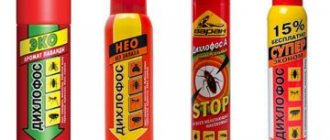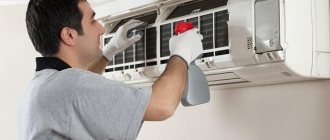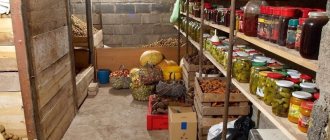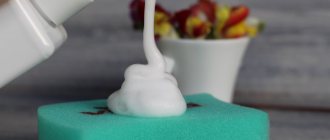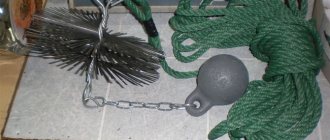Lining is one of the most popular materials for finishing baths and saunas. Natural wooden slats fit organically into the interior, maintaining environmental friendliness and a unique cozy atmosphere of the room. They look aesthetically pleasing and attractive, are easy to install and last a long time. In addition, wooden materials promote good air exchange, fill the room with a pleasant forest aroma and have healing properties.
But over time, the lining without proper care begins to darken and loses its attractive appearance. This occurs due to regular exposure to humidity, water and temperature changes. In addition, when using brooms, especially oak brooms, drops and splashes, which include tannins, fall on wooden surfaces. These elements cause natural wood to darken and turn black.
Soot and soot are integral elements when heating and using a bathhouse or sauna. They settle and gradually accumulate on the walls, floor and ceiling, on bath furniture and window sills. As a result, the materials lose their presentable appearance. Among other things, wood absorbs various fats and dirt, which causes dark spots on surfaces. In this article we will look at how to clean the lining in a bathhouse from soot, blackening and dirt.
Methods for cleaning soot from different surfaces
Before starting the process, cover the floor with oilcloth, plastic wrap or newspapers, then it will be much easier to collect black greasy dust.
The first stage in the fight against carbon deposits is dry cleaning. In order to wash away the soot, you will have to collect as much as possible of the residue with a vacuum cleaner (a simple attachment or a stiff brush will do) or a broom.
Next, treat the cleaned surface with one of the following products:
1. If the whitewashed ceiling and walls are damaged, wipe them with a clean rag soaked in medical alcohol or vodka (the composition will “corrode” the fat). A technical solvent will also cope with this role. Please note that it will not be possible to completely remove the soot after a fire - the surface will have to be whitened or repainted with water-based paint.
2. Floors covered with laminate, as well as plastic boards, baseboards, furniture, doors and window sills can withstand treatment with purified gasoline or any technical solvent (acetone, white spirit). Be careful when choosing brushes and sponges: metal or too hard tools can damage the coating.
4. The easiest way to clean wooden and metal surfaces, as well as brickwork, is with an abrasive substance (river sand, stone or brick chips, coarse table salt). In particularly advanced cases, a grinding machine will remove the soot.
In the case of brick walls, abrasives or high pressure water are required
5. It is enough to wipe glass surfaces with a clean cloth soaked in a soapy solution (use laundry soap or dishwashing gel) or damp newspapers.
6. Good results in the fight against soot (including in chimneys) are shown by special products that are sold in hardware and construction stores: sponges soaked in a greasy soot solvent, compositions such as “ChistDezo”, “Chimney Sweeper”, “BZ-20” " The highly concentrated MAZBIT+ remover will help you quickly remove soot from the walls in a bathhouse. To achieve maximum effect, use products according to the instructions on the package.
After removing soot, be sure to wipe the cleaned surface with a degreasing compound. For unpainted, acetone-resistant coatings, a solvent is suitable; in other cases, use a warm soapy solution. At the end of the work, ventilate the room thoroughly.
Soot. DIY soot remover.
Watch this video on YouTube
Author of the article: Nina Mitchenko, a housewife with more than 10 years of experience, sees her mission on the site in the transfer of experience
Your mark:
Chemical cleaning
The simplest and most reliable way to remove contaminants is to use liquid chemical compounds. They are evenly applied to the surface to be treated according to the instructions, and after a while they are washed off along with the dirt. Highly concentrated preparations contain alkaline components that promote rapid removal of soot from surfaces without damaging the wood structure.
Important! To clean wood surfaces, do not use abrasive-based powders or cleaning products. They can be replaced with neutral degreasing gels.
To quickly clean walls and floors, you can use a mop with a telescopic handle.
No less effective in the fight against soot are chemical sponges impregnated with deep penetration substances. They contribute to the quick and safe removal of the smallest particles of soot and soot that have penetrated the wood structure.
The principle of working with sponges is quite simple: holding the sponge with one hand, clean the surface from top to bottom.
Important! Chemical sponges quickly become clogged and become unusable, so for high-quality work it is recommended to purchase a sufficient supply of material.
Finally, it is recommended to wash the cleaned surface with clean water and wipe dry with a soft cloth. This is done as follows: the floor is covered with film or oilcloth to protect the surface from further contamination.
Next, clean water is poured into the container, to which a detergent composition, for example, for washing dishes, or any other degreasing agent is added. The soot is washed off with smooth movements using a soft sponge.
Prevention
To prevent the lining from turning black and deforming, it is enough to follow a few simple recommendations:
- if the facade of a building is covered with wooden clapboard, then it must be fixed at a short distance from the surface to be improved;
- after covering a wall, floor or ceiling with special boards, the building material must be processed (primed, varnished, painted, etc.);
- in a room lined with clapboard, you need to equip a good ventilation system;
- if it is impossible to install fans, regularly ventilate the room;
- Once every six months, the cladding board must be impregnated with a special protective compound, which minimizes the risk of mold and mildew and protects the building material from precipitation (how to treat lining with protective agents?).
And lastly: the higher quality lining is used for interior or exterior decoration, the less time and effort will be needed in the future to return the cladding board to its original appearance.
How to wash floors?
Detergents will help thoroughly clean the floor from dirt. To prevent fungi and mold, it is recommended to use hydrogen peroxide or “Whiteness”. They will permanently relieve the wooden covering from the formation of mucus. However, after treatment with these substances, the bathhouse must be ventilated so that a specific odor does not remain.
After each visit to the washing machine, the floors are washed with water and a liquid soap solution. This will allow them to remain clean and shiny for a long time.
Darkened floorboards that are resistant to cleaning liquids are cleaned with an electric planer. After removing and drying the wood, treat its top layer from 5 to 10 mm deep. Any sharp edges that appear are sanded using a machine. The thin darkened layer of the board is sanded off with sandpaper, and the corners are passed through with a drill.
To prevent severe contamination, mold, mildew and pests, the bathhouse is constantly kept clean. After each visit, it is thoroughly washed from the inside, not forgetting about all the components. Periodically, the internal surfaces are treated with antiseptics, and protective compounds are applied to the wood. If any element becomes unusable, it must be replaced immediately. Such care will allow you to enjoy comfortable rest for many years. Additional information about the proper maintenance of bathhouses can be found in our blog banya-guru.ru.
Special chemicals for soot removal
There are special chemical liquids designed to completely neutralize soot and unpleasant odors after fires. They are not sold in every store, but it is quite possible to get them in specialized retail outlets. They perfectly remove soot even from porous surfaces such as concrete and brick.
The most popular effective professional soot neutralizers:
- Facade cleaner No. 2.
- Mazbit+.
- Clean-Dezo.
- BZ-20.
The products are available in the form of colorless liquids poured into plastic canisters.
These were the most effective recommendations on how and how to wash off soot on your own. If there is extensive soot after a fire, it is better to call a special service for your own safety. A burnt-out room has a high concentration of toxins and it is necessary to work in it in a special protective suit.
Cleaning heating equipment
Soot can accumulate on the walls after a fire. It often forms around the fireplace. Before you start cleaning the walls from soot, the excess must be brushed off with a broom, brush or vacuum cleaner.
Next, the following substances will help you clean the walls from soot yourself:
- Special sponges soaked in soot-soluble liquid (sold in hardware stores).
- Alcohol. Napkins or gauze are soaked in it and carbon deposits are removed from the walls step by step.
- Petrol. This liquid also dissolves soot perfectly. Gauze is moistened in it and the surface of the walls is wiped.
The listed products can be used to clean any other surfaces (including the ceiling) that cannot be washed well with ordinary soap. In order not to stain the floor when cleaning the walls or ceiling, it is covered with plastic film or old newspapers.
Note! Heavy deposits of soot can rarely be washed off the walls without leaving a trace. Even if the blackness disappears, erased traces remain on the whitewash and wallpaper. Most likely, you will have to refresh the walls and cover them with new finishing material.
We suggest you read: Bathhouse for coughs, runny nose and sore throat: you can or cannot take a steam bath
Soot also settles on the glass. Any special glass cleaner will easily remove carbon deposits. Before using it, it is necessary to remove excess soot with a cloth, moistening it in a soap solution.
If there is no glass cleaner, then drop a little ammonia or vinegar into the water and finish washing the windows. To give the glass a crystal shine, use special microfiber cloths or plain newsprint.
Wood is a highly porous material. Soot particles can penetrate so deeply into its microholes that simple surface washing will not help. First, you should try to wash off the carbon deposits from the wood using any of the above methods (soap solution, alcohol, gasoline, ammonia solution). If the blackness does not go away, there is only one option left - sanding the wood.
For small surfaces, a piece of sandpaper will suffice. Larger areas are treated with a grinding machine.
When trying to put out a fire or even when cleaning a room from soot, you can get your clothes dirty. But there is no need to panic, soot is easily removed from fabrics. You don't need any special tools. Simply soak the item in soap or powder and then wash it in the washing machine at the maximum temperature allowed for the fabric.
For white items, you will most likely need to use bleach.
Note! Household carpet cleaners will help remove soot from the carpet. A washing vacuum cleaner will make the task easier.
Often, soot particles settle on the sauna stove and on the objects that surround it. What to do in this case? First, decide what material the stove or boiler is made of. After all, the methods for cleaning soot from different surfaces differ significantly! We suggest we talk about how to remove soot from bricks and metal structures.
Tools and products used during cleaning
When choosing mechanical soot removal, the following are used:
- various brushes with hard or metal bristles;
- sharpened metal scrapers or spatulas;
- a sharp knife or awl to remove soot from cracks and joints;
- special narrow brushes for the same purpose;
- sandpaper of different grain sizes;
- grinder with flap type grinding wheels.
Awl – for removing soot from narrow crevices
Flap type grinding wheel for cleaning large surfaces with an angle grinder
Melamine sponge for small light stains
A light coating of soot is wiped off with a melamine sponge, which acts like an eraser. But it wears out quickly, and several pieces will be needed to tidy up a large area.
Good results can be achieved by using folk cleaning agents - crushed brick or fine sand. You need to wash off soot with their help by pouring a layer of such abrasive onto a thick brush or hard sponge, and then wipe the contaminated areas.
Household chemicals for soot
Docker Mazbit plus - an effective remedy for soot and soot
To clean the bathhouse from soot deposits using a chemical method, you can purchase specialized cleaning agents:
- Mazbit+. Designed to remove fire marks on wooden surfaces. Easily cleans off fresh soot, preventing it from penetrating into cracks and pores.
- BZ-20. Alkaline cleaner used to remove greasy, sooty marks.
- Facade cleaner No. 2. In addition to washing soot, it disinfects, neutralizing substances with carcinogenic effects.
- Clean-Dezo. Used at the final stage to eliminate the burning smell.
Traditional methods
Vinegar essence diluted with water in a ratio of 1:2 helps to wash off soot from stove bricks. The solution is applied with a sponge to the smoked masonry, and after 10–15 minutes it is washed off with a damp cloth. To remove a dense layer of soot, vinegar is not diluted.
You can clean soot from bricks with ammonia. But then you will have to ventilate the bathhouse for a long time to remove its smell.
Surface treatment technology
When using specialized care products, the effectiveness of the results significantly increases - you can see them literally after the first time. How should the treatment be carried out to give the bathhouse an ideal look? We offer a common algorithm for all tools (depending on the type it will differ slightly, but this is a minor detail).
- Completely clean the surfaces needed for work from all kinds of debris; if it is impossible to remove dirt from the walls with a rag, use sandpaper (with a fine abrasive).
- Soak the sponge, rag or roller you will use in the future in a safe bath detergent You need to apply several layers for a more visible result. Pay special attention to cuts and damage to the integrity of the tree. These are the places where microorganisms accumulate the most.
- The surface is cleaned with only one selected product. Avoid mixing with third party objects. Otherwise, a chemical reaction may occur.
- If traces of insects are detected, use disinfectant cleaning methods.
- Always strictly follow the rules provided by the manufacturer's instructions.
Specialized mixtures do not contain substances such as chlorine. Therefore, avoid connecting it with them. Destruction of microbes and bugs, dirt from all types of surfaces, rather dense deposits on the walls - this product is capable of everything. Thanks to its use, everything in your bathhouse will become clean: windows, doors, ceilings, walls, floors, glass and stone surfaces and more.
Additional advantages include the following: a pleasant aromatic smell that remains after use, it causes irritation and allergies; no marks or cloudy stains from a sponge or brush; removal of fungal and other infections, and lack of toxicity.
We recommend MAZBIT PLUS soot and soot remover
MAZBIT PLUS - Concentrated product designed to clean surfaces from the effects of fire. Designed for effective quick cleaning of any surfaces: general construction materials: wood, concrete, plaster, stone, tiles from various contaminations by combustion products: soot, soot, carbon deposits.
More details
It is very important to monitor this moment and try to prevent it in time. The quality of the wood may change, and it will no longer be possible to restore its original beauty.
The quality of the wood may change, and it will no longer be possible to restore its original beauty.
At first glance, it may seem that cleaning the bathhouse from soot on your own will be very difficult, especially if the soot deposit is already very old. But actually it is not.
Brick
How to remove soot from a brick stove in a bathhouse? One of the most effective methods is to use a simple detergent and sponge. You need to take the detergent, dilute it with water and whisk until a thick foam forms. The treated surface should be left for 10-15 minutes, then rinsed with water.
Another great way is to use vinegar essence. You will need tap water and table vinegar. For one glass of vinegar you need to take two glasses of water. Don't forget to use gloves! Apply the solution to the brick, leave for 10 minutes, then rinse thoroughly. How to wash off soot if it has penetrated deep enough into the brick pores?
Tags: bathhouse, wood, soot, wash off
« Previous entry
Prevention of soot and soot formation in the bathhouse
The chimney in the bathhouse must be regularly cleaned of soot with a hard brush.
The main obstacle to the escape of smoke from the stove into the steam room is the good condition of the smoke exhaust channels. To maintain draft in the chimney, measures must be taken regularly:
- Monitor the condition of the brickwork. Any cracks in it must be immediately sealed with cement mortar.
- Clean the chimney from soot deposits inside. You don’t even have to buy special compounds, but use used bath brooms. They need to be tied in a bunch with the branches down, attached to a long rope and hung with a load.
- If it is not possible to clean the stove by mechanical means, you sometimes need to heat it with special chimney sweep logs. Alder or aspen firewood, or potato peelings are suitable for this purpose.
- Rake out the ash from the ash pit after each fire of the stove.
- Clean the entire steam room several times a year with a soda solution and a stiff brush.
If a hot water supply is connected to the room, it is recommended to spray the walls and ceiling with a pressure hose in a cooled bath.
All this will reduce the build-up of soot in the steam room, and it will not have to be cleaned often.
Mechanical dry cleaning
To simplify and speed up the task, you can take a grinding machine. Use flap-type wheels with a grit rating of 35 and a diameter of up to 12.5 centimeters. After such cleaning and processing, dust will remain on the surface, which can be removed with a clean cloth and soapy water.
To prevent dirt, grime and dust from accumulating on the walls, to prevent the formation of serious, old and difficult stains and dirt, carry out regular preventative cleaning. After each heating of the sauna, clean the floor and walls with a soft wood brush. Once a month, carry out wet cleaning using a soap solution.
Don't forget to clean your stove chimney regularly. This needs to be done even if you rarely heat the bathhouse. Soot and soot, dirt and debris accumulate inside the bathhouse. As a result, the draft deteriorates and the stove becomes difficult to light. Due to soot and debris, carbon monoxide is formed in the furnace piping channels, which is harmful to human health.
If the draft is poor and the pipe is clogged, the smoke will fall back into the bathhouse, polluting the air, walls and floor, ceiling and furniture. Lining and other wooden materials will quickly turn black. How to clean the chimney in a stove yourself, see the link https://vsepodomu.ru/uborka/kak-pochistit-dymohod-v-pechi/.
Source
What to use?
Lining is a “breathing” building material, so it regularly absorbs dust, dirt, soot, and other types of contaminants from the air.
Coating its surface helps reduce damage to wood:
- impregnations;
- wax;
- paints (how to paint lining correctly?);
- varnish (how to varnish the lining?).
But even they will not completely protect the finishing board from stains appearing on it. What can and cannot be used to clean the lining?
Recommended means of removing contaminants from finishing materials include:
- soap solutions;
- scrapers with sharp bases;
- brushes for cleaning wood;
- grinding machines.
Before sanding the lining, you need to carry out a test stripping on a separate piece of material or on the least noticeable area of the surface being treated. Otherwise, instead of a clean slate, you may end up with completely damaged material.
What should not be used?
Do not clean the finishing board with:
- Hard metal brushes and sponges. Their aggressive impact will lead to an increase in wood porosity and even deeper penetration of contamination.
- Household chemicals (washing powder, dishwashing detergent, liquid soap). Such detergent compositions are not intended to work with lining, so the result of their impact on it is difficult to predict.
- Acidic, alkaline or chlorinated compounds for household use. For example, Belizna or Domestos are very helpful during cleaning, but they are completely unsuitable for disinfecting finishing building materials.
Firstly, all aggressive cleaning products have a strong, unpleasant odor that is absorbed into the wood literally forever. And, secondly, they reduce the protective functions of paints and varnishes, significantly reducing the service life of the lining.
Metal
Cleaning metal structures is a fairly simple procedure: you will need a clean, damp sponge and soap solution. If the soot layer is too dense, you can use fine river sand. True, it must be borne in mind that abrasive materials perfectly clean metal, but at the same time they contribute to the appearance of corrosion and can destroy it.
For this reason, experts recommend using abrasives only if no other cleaning method is suitable. After this, it is necessary to paint all damaged surfaces. Neutral chemical compounds and removers are much better suited, because they will not only clean the metal surface, but also will not damage it. Among the folk methods, one can note the purification of metal using water in which citric acid is diluted, or Coca-Cola.
Basic recommendations for surface cleaning
Wood is a natural material that is highly hygroscopic. Together with water, wooden surfaces can absorb any type of contaminant - soot, soot, sweat, dust, etc. Therefore, it is not recommended to clean wood floors, walls and ceilings covered with soot with water.
When considering the question of how to wash off soot in a bathhouse on walls and other bases, you need to exclude the following products:
- water;
- laundry or liquid soap;
- soft or abrasive sponges;
- hard brushes;
- spray.
Such products can be used for final cleaning after carbon deposits have been removed from the wood.
To clean the walls and floor of the bathhouse from plaque and soot, it is recommended that all work be carried out using personal protective equipment:
- rubber gloves;
- glasses;
- gauze bandage or petal respirator;
- robe;
- cap or scarf.
Many owners wonder how to clean a bathhouse from dirt and soot with their own hands. There are two cleaning methods available:
- mechanical devices;
- chemical compositions.
Mechanical cleaning
You can safely remove the resulting soot from ceiling, wall and floor surfaces using special devices - a scraper with a sharp base or a spatula. They allow you to dry clean every centimeter of surface dirt. To put this cleaning method into practice, you will need a lot of free time and physical endurance.
To prevent serious contamination of surfaces, after each firing of the sauna stove, the floor and walls must be thoroughly cleaned with a soft brush intended for wood.
To simplify the task of removing soot, experts recommend using a grinding machine with a flap-type wheel with a diameter of up to 12.5 cm and a grain size of 35 units. You can remove the resulting dust after cleaning the surfaces with a clean rag and soap solution.
When and why to clean the chimney
Chimneys of stoves and fireplaces operating on solid or liquid fuel need regular cleaning. When it burns, ash is formed, which remains in the firebox, as well as soot, which settles on the inner surface of the chimney. Its quantity depends on the type of firewood, combustion temperature, frequency of use of the heating device and other parameters.
But while it’s easy to control the condition of the firebox, you can only find out what’s going on in the chimney after an inspection. If the stove is in constant use, then such an inspection must be carried out at least twice a year - before the start of the heating season (at the end of summer) and after its completion (in the spring).
Based on the results, a decision is made on how to clean the chimney - radically, using mechanical means, or you can do it in less labor-intensive ways. This depends on the thickness of the soot on the walls and the presence of foreign objects in the channel, such as dry leaves, bird nests and other debris. If they are present, and the plaque has grown by more than 2-3 mm, a major cleaning is needed.
Smoke channel overgrown with sootSource legkovmeste.ru
If this is not done, the following unpleasant consequences are possible:
Overgrown with soot, the lumen of the chimney narrows, and smoke can no longer freely escape through it, so part of it lingers in the firebox, penetrating into the room and worsening combustion. This is also facilitated by poor heating of the chimney walls, which reduces draft;
- carbon monoxide entering a room often causes severe poisoning with a sad outcome;
- a thick layer of soot in the pipe can ignite, and hot sparks flying out of it can cause a fire;
- the penetration of smoke into the house, even without serious consequences, is an unpleasant odor and soot on all surfaces.
Traces of soot on the outer surface of the stove indicate poor draftSource i.ytimg.com
How to clean an unpainted wooden floor
Before mopping wood floors, remove debris and dust. It tends to get caught in joints and accumulate in the form of unsightly black stripes that are difficult to remove. Use a broom or vacuum cleaner with a floor cleaning attachment attached.
Unpainted wood instantly absorbs moisture, so it is not recommended to wet the boards excessively. Due to dampness, they become deformed and begin to creak when a person steps on the floor.
Read also: Make a broken glass cake
The method of cleaning a wooden covering depends on the type of contamination:
- If there are black shoe stains on the boards, use baking soda. Dissolve a spoonful of soda powder in a liter of water. Take a brush, clean the dirt, wash the floor with clean water and dry.
- Try removing old blots with table vinegar. Mix 2 tablespoons of vinegar and ammonia in 4 liters of heated water. Put on latex gloves and wash the boards, paying special attention to dirty areas.
- Marks from spilled juice are washed off in several stages. Soak cotton wool in ammonia and soak the stain. If it is firmly stuck in, add a pinch of baking soda and rub with a dry sponge. Remove any remaining crystals with a damp cloth and wash the floor.
For routine cleaning, fill a bucket with hot water, soak a soft cotton cloth in it, wring it out, and mop or hand wash the floor. Uneaten dirt will quickly be cleaned, and the tree will shine with cleanliness. Finally, wipe the coating with a dry cloth made of natural material.
Cleaning the chimney with a regular brush
Before proceeding directly to cleaning the chimney, the furniture in the bathhouse should be covered with plastic film and the windows should be covered with thick fabric. You also need to prepare protective equipment for yourself: wear gloves, goggles and a respirator. Then you should inspect the stove and find out whether it has special inspection doors that make cleaning easier and more convenient. First, you need to wait until the stove has completely cooled down, then remove any remaining wood or any other flammable materials from it.
After this, you need to remove the damper at the entrance to the chimney. Holding the brush firmly by the handle, insert it into the chimney opening. With confident movements of the brush in various directions, you must try to reach the most difficult to reach places in the chimney. As the brush moves further up, you should clean the highest places in the pipes. Then you need to remove all spilled soot, close the chimney, and rinse the brush with regular warm water.
It is necessary to remove not only soot from the chimney, but also cobwebs, accidentally flying debris, etc. Even after a high-quality cleaning of the chimney, a second cleaning will be required after a couple of months (especially in the summer), since during this time cobwebs and dust may form in the chimney and soot.
If you don’t have a regular high-quality chimney cleaning brush at hand, you can make one yourself. To do this, you will need an ordinary synthetic round broom, a steel cable, the length of which is equal to the length of the entire chimney, clamps, two “ears,” a pin with an 8 mm thread and washers of different diameters. It is necessary to bend the pile in different directions. This will not be so easy to do, since it is quite hard and elastic. The result will be something that looks like a bouquet.
If it is difficult to straighten the pile, it is recommended to first immerse it in boiling water. Then you need to take a hairpin and screw the “ear” on one end, then put on the washer and insert it into the hole at the bottom of the brush, then put the washer back on. Their diameter will match the broom holes. By pressing on the base from above, you should carefully screw on the second fastener. The more you have to twist, the more the bristles of the brush will spread to the sides. Then you need to turn the brush over and tighten the “ear” of its fastening to the appropriate size. After this, you need to secure the cable to the brush using a bracket, measure the chimney opening and cut the fibers exactly to the size of the chimney pipe.
You should be careful here, since with smaller sizes such a brush will not clean. And for accuracy, it is recommended to first try on and cut out a template from cardboard. And finally, you need to adapt the load - it can be a regular weight from 2 kg.
Why does the chimney become dirty?
How to clean a chimney in a bathhouse depends on the nature of the contamination. With use, types of clogging may occur such as:
- soot and soot, which accumulates very quickly when burning household waste;
- condensation that forms due to irregular use of the bathhouse;
- foreign objects accidentally falling into the chimney.
All of these types of contaminants ultimately impede the free circulation of air and the escape of smoke through the chimney. This may cause carbon monoxide poisoning. Condensate is a weakly concentrated acid solution. Under its influence, the chimney masonry begins to collapse from resinous deposits.
If you use a sauna regularly, you need to make a schedule and determine in advance when and how to clean the pipe in the sauna. Carrying out such work regularly will preserve the chimney and stove and allow you to use the sauna without any problems.
The chimney and pipe in the bathhouse are cleaned chemically and/or mechanically. In a special store you can purchase liquids and/or powders for cleaning the chimney. Detailed instructions are printed on the packaging. After reading it, it will become clear how to clean a pipe in a bathhouse.
A good answer to the question of how to clean soot in a bathhouse that has accumulated in a chimney would be a “log chimney sweep.” It is impregnated with special chemicals. During combustion in the furnace, smoke of a special composition is released. As a result, the soot becomes soft and pliable. After 2 or 3 days it can be removed with brushes without much difficulty.
For mechanical cleaning of the chimney you will need the following tools and devices:
- rope and/or rope;
- weight (ball);
- brush-ruff (preferably on a thin metal cable).
First you need to check the safety of the structure. Then you need to remove any objects that accidentally got into them from the pipe and chimney. For this purpose, a brush-ruff is used, selected according to the size and shape of the pipe.
A special modern brush will make cleaning work easier. It comes with a handle consisting of several links. This allows you to adjust the length of the brush as needed. During cleaning work, any brush must be moved inside the pipe, gradually moving it lower and lower.
Such work must be performed in a special set of clothing, which must include:
- overalls or suit;
- respirator;
- gloves;
- protective glasses.
If the chimney is not very dirty, you can call a specialist. He will clean it using a special high-power vacuum cleaner. This will remove soot from the chimney through the firebox opening. The use of special means will help resolve the issue of how to clean the chimney of contaminants and how to clean the pipe of soot in a bathhouse.
Removing clogs through a fireplace
Mechanical cleaning of the chimney from the roof can be problem-free only if the channel runs straight. If the pipe has an angle, a turn, or an elbow, then you will have to do cleaning work from the side of the stove, because the tool will get stuck in the passage, and there will be no way to thoroughly and completely clean the hole.
Since it is much more difficult to remove soot from below due to the fact that gravity resists penetration, there are additional devices for cleaning from below - elastic rods with a handle, a flexible rope of large diameter with meter markings, stackable rods that are put on each other to adjust the length.
Causes of soot and soot
Smoke with soot appears due to the low combustion temperature in the furnace or an improperly organized traction system. In such cases, when the boiler door is opened, clouds of smoke will come out and be absorbed by the walls. There are a number of other reasons why soot accumulates:
- The chimney pipe becomes overgrown with soot or a foreign object gets inside, making it difficult to remove the soot.
- Errors in the construction of heating equipment. Incorrect slopes, incorrect location of the smoke exhaust duct and the design of the stove itself can cause soot to appear. Only a thorough modification of the sauna heating will correct the situation.
- Strong wind. If the weather is bad outside, the wind can blow into the chimney. This will cause smoke to escape in the opposite direction. In this case, soot on the walls is inevitable. Some designs include a ridge, but often if the wind direction is unfavorable, it is absolutely useless.
- The appearance of cracks in brickwork. New holes begin to draw air out of the oven from all sides. This causes smoke to escape from the firebox. Even if you manage to ventilate the room, soot will still fall on the surface of the wooden walls.
- Smoke. If, after a long break, the firebox is not preheated, then smoke penetration into the room is inevitable. To prevent this, before starting the kindling, throw a few newspapers or a rag doused with gasoline inside, then set it on fire.
Single-story baths are a common practice; accordingly, the smoke exhaust system will be located lower. Therefore, bad weather and other factors that prevent normal air circulation inside the stove will cause smoke inside the room.
Cleaning walls in a bathhouse with ammonia diluted with waterSource dizainvfoto.ru
What is the difference between a specialized and a conventional product?
It’s worth starting with the environment and atmosphere that reigns inside steam rooms, baths, and saunas. Their main purpose is to steam and wash. Therefore, water and high temperature are constant companions of such premises. The temperature ranges from 60 to 100 degrees depending on preference manually: by pouring cold water on the stones (to cool the heat), or by throwing firewood into the stove/switching the artificial apparatus to higher settings (to add heat).
Constant temperature changes, high levels of humidity, and the use of wood materials inherent in saunas have determined the need to use a safe detergent for baths.
Metal chimneys, their operation and care
Metal chimneys can be single-walled or insulated, that is, a sandwich. The former are considered cheap, but owners note the short service life of such chimney systems, the presence of condensation, and the rapid appearance of plaque inside the pipes. Modern single-circuit chimneys may have an enamel coating on the internal walls, which protects against excessively rapid accumulation of soot.
Enameled chimneys "AGNI"
Insulated double-wall chimneys, if installed correctly, can solve the problem of condensation, and since the internal walls are as smooth as possible, soot accumulates more slowly than in brick chimneys. But this does not relieve owners of metal chimneys from the need for periodic cleaning.
Chimney and additional elements
Installation options for a metal chimney
Step 1. Inspection of the chimney
Check the chimney draft. Open the inspection plugs and shine a flashlight inside
Please note that if a large layer of soot is noticeable on the seams of the chimney and its joints, this indicates that depressurization has occurred. In this case, the chimney will have to be disassembled and reassembled, applying a layer of heat-resistant sealant
After installation work, the draft level is checked again.
Applying sealant when assembling the chimney
During the inspection process, it is necessary to pay attention to the ceiling cuts, as well as the surfaces adjacent to them. If there is such a need, you need to add heat-insulating materials or repair the structure
Ceiling cuts
Typical faults and solutions
Step 2. Primary cleaning
It is recommended to carry out cleaning work in dry, sunny, windless weather. If there is bad weather and rain outside, it is better to postpone the procedure until another day. When climbing onto the roof, always use safety ropes.
Remove the chimney hood (head, deflector). Inside the chimney you can find not only soot and soot, but also bird nests, insects and other foreign objects. It is necessary to remove them by pushing them out with a long-handled brush or any other convenient object.
Remove the chimney hood before cleaning
Step 3. Soot removal
Each factory metal chimney is supplied with detailed installation and operating instructions. And all manufacturers indicate that cleaning the chimney using the burning method is prohibited. Cleaning of a metal chimney is carried out only mechanically.
Cleaning the walls in the bathhouse
Most often, those objects where there is a constant thermal load are exposed to soot and soot. It is not so easy to wash them off. You can remove soot from wood using one of the following methods:
- Mechanical. Wood perfectly absorbs odors, so in order to completely remove soot or soot, you need to completely scrape it off with any hard object or sanding machine.
- Another way to remove soot from walls is to create a cleansing scrub designed for treating wooden surfaces. It may be based on sand or crushed brick. It should be mixed with a small amount of water, and the resulting slurry should be used to clean the damaged surfaces.
- Another way to wash soot in a bathhouse is to use ready-made products. It is necessary to purchase only those household chemicals that are suitable for treating the internal surfaces of baths. Most often, they contain alkaline substances. They are not absorbed into wood and will begin to affect the human respiratory system when heated.
Getting rid of soot can be difficult. In addition, during the cleaning process you can damage the walls, floor or ceiling, and it will be almost impossible to get rid of the resulting defects. Do not allow soot to appear. To do this, you need to wipe the surfaces with soap and water after each visit to the bathhouse or sauna.
Main recommendations
An important rule is to never use water or abrasive devices to clean wood walls. Immediately exclude such aids as:
When cleaning the bathhouse, be sure to follow safety rules and wear clothing that makes contact with chemicals safe. These items include:
When using special cleaning products for wood, be sure to read the instructions. Otherwise, you may harm the wood partitions.
Complete cleaning of the apartment
For cleaning to be successful, the apartment must be cleaned step by step and correctly.
You need to start with dry cleaning of distant rooms and finish it in the bathroom and toilet. Most of the soot accumulates at the top as smoke and fine particles rise upward.
Open all the windows in your house or apartment. This must be done so that the smell of smoke disappears. If there was a fire, all damaged items must be taken outside. Remove visible debris. Curtains and carpets are removed and taken outside. They will need to be shaken well and washed. Alternatively, you can also take it to the dry cleaner.
After cleaning up the trash, start cleaning the ceiling and walls. If there is burnt wallpaper on the walls, remove it with a staple. Wash windows, window sills, windows and doors thoroughly.
If there was a fire in the room, it is better that all surfaces remain clean after it, otherwise, after repairs, a burning smell may persist.
Now take a broom and walk it over the entire surface of the house. This way you can collect small soot particles. Next, use a vacuum cleaner. Walk it over all surfaces to collect the smallest particles of dirt. Finally, carry out wet cleaning, adding detergent to the water.
Change the water more often to prevent soot residue from settling back on the surface. It is best to throw dirty water outside if possible. The main thing is not to rush during the work process, otherwise if you miss something, you will need to start all over again.
Preventing contamination of unpainted wooden floors
Wooden floors look presentable and beautiful, but require careful maintenance. To maintain its cleanliness and smoothness, proper prevention is needed.
To clean parquet and plank floors, use gentle products. It is not recommended to use:
- preparations with chlorine;
- abrasives;
- steam cleaners;
- metal brushes.
The surface of unpainted boards does not tolerate dust. Vacuum the floors twice a week, carefully working through the joints and removing dirt from them.
Place a rug near the front door and wipe your shoes when entering the house. Sand and small pebbles accidentally brought into the room can scratch the boards.
Do not spill water on the floor or allow dampness in the apartment, even if the wood is varnished. This will help prevent the boards from swelling and warping.
Wipe off any types of dirt on the floor immediately. Wood quickly absorbs grease and moisture, so old stains are more difficult to deal with.
So, today we will talk in detail about putting things in order in the bathhouse. Simply put, about how to clean a bathhouse.
I distinguish three types of cleaning. The first is general. I do it once a month. For those who often have guests in the bathhouse, I strongly recommend doing it more often.
Read also: Clover tincture for blood vessels
“A good owner has everything in its place,” my grandmother told me. Each item serves a specific purpose. Everything has its own system. It rests on three cornerstones. Improvement, cleanliness, order.
I constantly monitor the state of affairs in my bathhouse empire. As soon as a soldier of my army of hot-steam troops loses his position, I immediately rush to his aid. Something is constantly being repaired, updated, replaced with something new.
An ordinary broom, brush, pemoxol, and old washcloths that have served their time help me in this matter. I stock up on water thoroughly, because I have to do a lot of washing. And my war zone is vast
